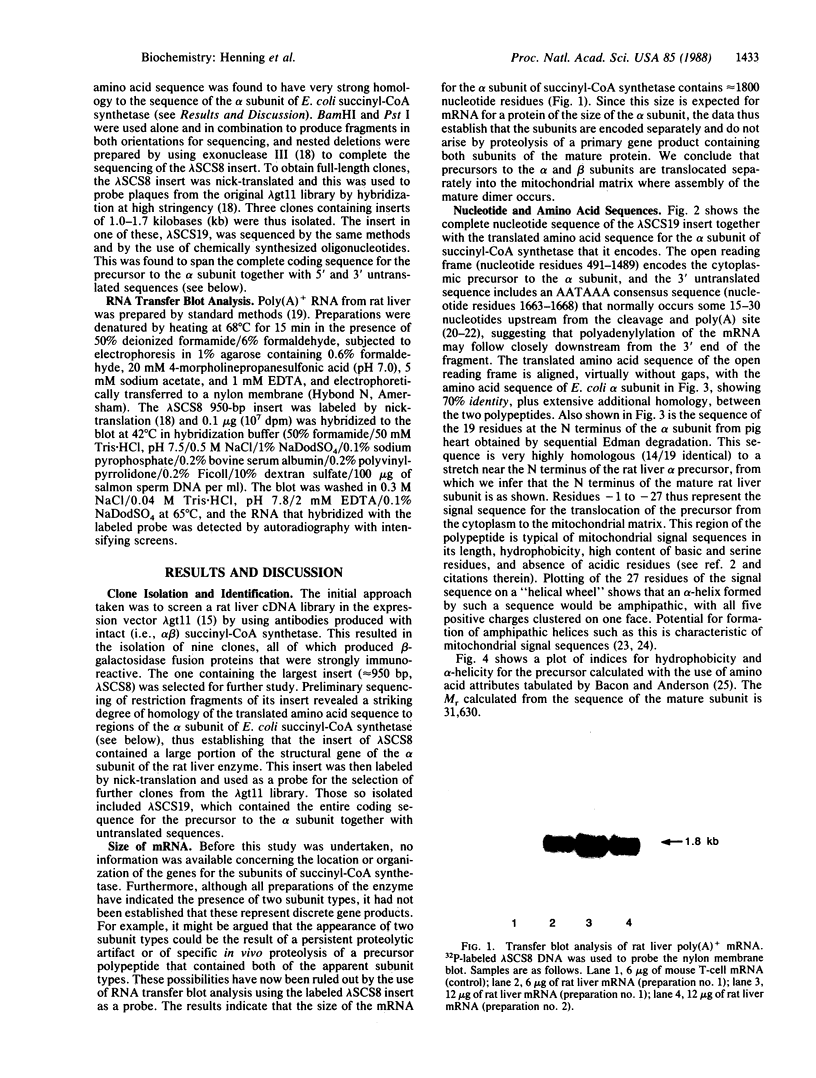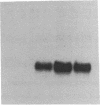Abstract
Succinyl-CoA synthetase [succinate-CoA ligase (GDP-forming); EC 6.2.1.4] of rat liver, an alpha beta dimer, is a component of the enzymology of the tricarboxylic acid cycle and functions within the mitochondrial matrix. We have isolated and determined the sequence of a cDNA clone containing the coding sequence of the cytoplasmic precursor to the alpha subunit of this enzyme together with stretches of nontranslated sequence at the 5' and 3' ends. The translated amino acid sequence indicates the presence of a 27-residue N-terminal signal sequence for mitochondrial targeting. The amino acid sequence of the mature alpha subunit shows an extraordinary degree of homology to the alpha subunit of Escherichia coli succinyl-CoA synthetase, with greater than 70% of the residues identical. This suggests that the fundamental differences in the quaternary structures and catalytic functions of the mammalian and bacterial enzymes must be attributable to differences in the beta subunits. mRNA that hybridizes to the cloned DNA is approximately equal to 1800 nucleotide residues in length, confirming that each of the two subunits is encoded separately and does not arise by proteolysis of a primary gene product containing both subunits of the mature protein.
Full text
PDF




Images in this article
Selected References
These references are in PubMed. This may not be the complete list of references from this article.
- Bacon D. J., Anderson W. F. Multiple sequence alignment. J Mol Biol. 1986 Sep 20;191(2):153–161. doi: 10.1016/0022-2836(86)90252-4. [DOI] [PubMed] [Google Scholar]
- Ball D. J., Nishimura J. S. Affinity chromatography and affinity labeling of rat liver succinyl-CoA synthetase. J Biol Chem. 1980 Nov 25;255(22):10805–10812. [PubMed] [Google Scholar]
- Buck D., Spencer M. E., Guest J. R. Cloning and expression of the succinyl-CoA synthetase genes of Escherichia coli K12. J Gen Microbiol. 1986 Jun;132(6):1753–1762. doi: 10.1099/00221287-132-6-1753. [DOI] [PubMed] [Google Scholar]
- Buck D., Spencer M. E., Guest J. R. Primary structure of the succinyl-CoA synthetase of Escherichia coli. Biochemistry. 1985 Oct 22;24(22):6245–6252. doi: 10.1021/bi00343a031. [DOI] [PubMed] [Google Scholar]
- Chirgwin J. M., Przybyla A. E., MacDonald R. J., Rutter W. J. Isolation of biologically active ribonucleic acid from sources enriched in ribonuclease. Biochemistry. 1979 Nov 27;18(24):5294–5299. doi: 10.1021/bi00591a005. [DOI] [PubMed] [Google Scholar]
- Fitzgerald M., Shenk T. The sequence 5'-AAUAAA-3'forms parts of the recognition site for polyadenylation of late SV40 mRNAs. Cell. 1981 Apr;24(1):251–260. doi: 10.1016/0092-8674(81)90521-3. [DOI] [PubMed] [Google Scholar]
- Hartl F. U., Schmidt B., Wachter E., Weiss H., Neupert W. Transport into mitochondria and intramitochondrial sorting of the Fe/S protein of ubiquinol-cytochrome c reductase. Cell. 1986 Dec 26;47(6):939–951. doi: 10.1016/0092-8674(86)90809-3. [DOI] [PubMed] [Google Scholar]
- Hay R., Böhni P., Gasser S. How mitochondria import proteins. Biochim Biophys Acta. 1984 Jan 27;779(1):65–87. doi: 10.1016/0304-4157(84)90004-2. [DOI] [PubMed] [Google Scholar]
- Hurt E. C., Pesold-Hurt B., Suda K., Oppliger W., Schatz G. The first twelve amino acids (less than half of the pre-sequence) of an imported mitochondrial protein can direct mouse cytosolic dihydrofolate reductase into the yeast mitochondrial matrix. EMBO J. 1985 Aug;4(8):2061–2068. doi: 10.1002/j.1460-2075.1985.tb03892.x. [DOI] [PMC free article] [PubMed] [Google Scholar]
- Ludmerer S. W., Schimmel P. Gene for yeast glutamine tRNA synthetase encodes a large amino-terminal extension and provides a strong confirmation of the signature sequence for a group of the aminoacyl-tRNA synthetases. J Biol Chem. 1987 Aug 5;262(22):10801–10806. [PubMed] [Google Scholar]
- Montell C., Fisher E. F., Caruthers M. H., Berk A. J. Inhibition of RNA cleavage but not polyadenylation by a point mutation in mRNA 3' consensus sequence AAUAAA. Nature. 1983 Oct 13;305(5935):600–605. doi: 10.1038/305600a0. [DOI] [PubMed] [Google Scholar]
- Nguyen M., Argan C., Lusty C. J., Shore G. C. Import and processing of hybrid proteins by mammalian mitochondria in vitro. J Biol Chem. 1986 Jan 15;261(2):800–805. [PubMed] [Google Scholar]
- Pearson P. H., Bridger W. A. Catalysis of a step of the overall reaction by the alpha subunit of Escherichia coli succinyl coenzyme A synthetase. J Biol Chem. 1975 Nov 10;250(21):8524–8529. [PubMed] [Google Scholar]
- Pfanner N., Tropschug M., Neupert W. Mitochondrial protein import: nucleoside triphosphates are involved in conferring import-competence to precursors. Cell. 1987 Jun 19;49(6):815–823. doi: 10.1016/0092-8674(87)90619-2. [DOI] [PubMed] [Google Scholar]
- Proudfoot N. J., Brownlee G. G. 3' non-coding region sequences in eukaryotic messenger RNA. Nature. 1976 Sep 16;263(5574):211–214. doi: 10.1038/263211a0. [DOI] [PubMed] [Google Scholar]
- Robinson J. B., Jr, Inman L., Sumegi B., Srere P. A. Further characterization of the Krebs tricarboxylic acid cycle metabolon. J Biol Chem. 1987 Feb 5;262(4):1786–1790. [PubMed] [Google Scholar]
- Robinson J. B., Jr, Srere P. A. Organization of Krebs tricarboxylic acid cycle enzymes in mitochondria. J Biol Chem. 1985 Sep 5;260(19):10800–10805. [PubMed] [Google Scholar]
- Roise D., Horvath S. J., Tomich J. M., Richards J. H., Schatz G. A chemically synthesized pre-sequence of an imported mitochondrial protein can form an amphiphilic helix and perturb natural and artificial phospholipid bilayers. EMBO J. 1986 Jun;5(6):1327–1334. doi: 10.1002/j.1460-2075.1986.tb04363.x. [DOI] [PMC free article] [PubMed] [Google Scholar]
- Sanger F., Nicklen S., Coulson A. R. DNA sequencing with chain-terminating inhibitors. Proc Natl Acad Sci U S A. 1977 Dec;74(12):5463–5467. doi: 10.1073/pnas.74.12.5463. [DOI] [PMC free article] [PubMed] [Google Scholar]
- Vieira J., Messing J. The pUC plasmids, an M13mp7-derived system for insertion mutagenesis and sequencing with synthetic universal primers. Gene. 1982 Oct;19(3):259–268. doi: 10.1016/0378-1119(82)90015-4. [DOI] [PubMed] [Google Scholar]
- Vogel H. J., Bridger W. A. A phosphorus 31 nuclear magnetic resonance study of the intermediates of the Escherichia coli succinyl coenzyme A synthetase reaction. Evidence for substrate synergism and catalytic cooperativity. J Biol Chem. 1982 May 10;257(9):4834–4842. [PubMed] [Google Scholar]
- Wang T., Jurásek L., Bridger W. A. Succinyl coenzyme A synthetase of Escherichia coli. Sequence of a peptide containing the active-site phosphohistidine residue. Biochemistry. 1972 May 23;11(11):2067–2070. doi: 10.1021/bi00761a011. [DOI] [PubMed] [Google Scholar]
- Weitzman P. D., Jenkins T., Else A. J., Holt R. A. Occurrence of two distinct succinate thiokinases in animal tissues. FEBS Lett. 1986 Apr 7;199(1):57–60. doi: 10.1016/0014-5793(86)81223-6. [DOI] [PubMed] [Google Scholar]
- Wolodko W. T., Brownie E. R., O'Connor M. D., Bridger W. A. Thiophosphorylation as a probe for subunit interactions in Escherichia coli succinyl coenzyme A synthetase. Further evidence for catalytic cooperativity and substrate synergism. J Biol Chem. 1983 Dec 10;258(23):14116–14119. [PubMed] [Google Scholar]
- Wolodko W. T., Kay C. M., Bridger W. A. Active enzyme sedimentation, sedimentation velocity, and sedimentation equilibrium studies of succinyl-CoA synthetases of porcine heart and Escherichia coli. Biochemistry. 1986 Sep 23;25(19):5420–5425. doi: 10.1021/bi00367a012. [DOI] [PubMed] [Google Scholar]
- Wolodko W. T., O'Connor M. D., Bridger W. A. Capacity for alternating sites cooperativity in catalysis by succinyl-coenzyme A synthetase. Proc Natl Acad Sci U S A. 1981 Apr;78(4):2140–2144. doi: 10.1073/pnas.78.4.2140. [DOI] [PMC free article] [PubMed] [Google Scholar]
- von Heijne G. Mitochondrial targeting sequences may form amphiphilic helices. EMBO J. 1986 Jun;5(6):1335–1342. doi: 10.1002/j.1460-2075.1986.tb04364.x. [DOI] [PMC free article] [PubMed] [Google Scholar]



